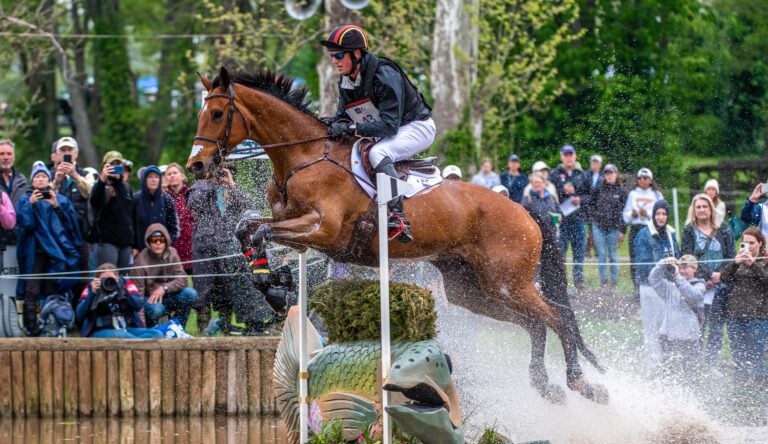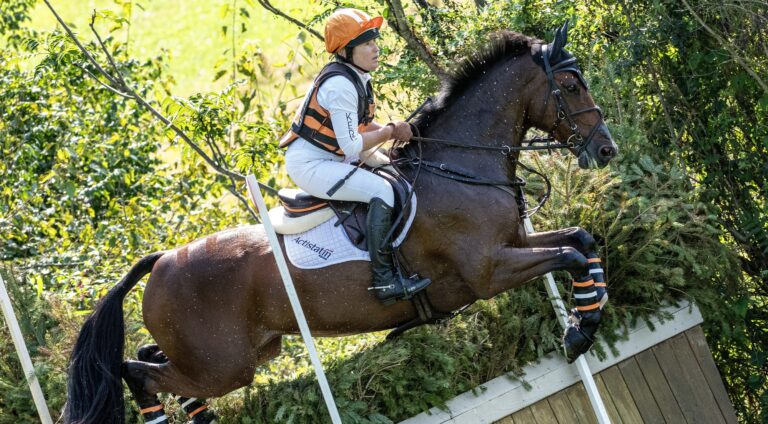
My home is in Ontario, where we often are stuck with riding in indoor arenas from December until the end of April. The early-season events begin in May so we need a way to begin getting our horses fit before we’re able to take them outside for the gallops, hill work and other exercises that are part of a standard fitness program.
A simple strategy that works well for me and my students uses canter work over raised cavalletti to build fitness by increasing our horses’ respiration and heart rates. This program is helpful for conditioning hunters and jumpers as well as eventers, and you also can use it in an outdoor ring with good footing when mud or other problems keep you away from your usual warm-weather conditioning venues.
Here’s how it works: I begin with poles on the ground, spaced as bounces so that the horse goes over a pole with each canter stride. For most horses, this means 9-foot spacing between the poles. I start with three poles in a line and as the horse becomes comfortable with the exercise we work our way up to seven or sometimes as many as nine poles. When the horse is relaxed with the poles in a straight line, I configure them on a curve so that when cantering across the centers of the poles, the horse is on a 20-meter circle. As I’ll explain later when I demonstrate the exercise, the work on a circle creates additional demands on both horse and rider.
The next phase of the exercise is to raise the cavalletti so that the horse is actually jumping a series of small bounces. I use the standard cavalletti blocks (the same type of blocks I’m using in these photos) to raise the poles a few inches for lower-level horses. For more advanced horses, I may eventually raise the poles on standards to create small verticals no higher than 2 feet.
I make the transition from poles on the ground to raised cavalletti in stages: If it’s a line of three cavalletti, I first raise the middle one. After the horse has cantered through this comfortably a couple of times, I raise the third one. Finally I raise the first one. If I’m raising a line of five poles we begin by raising the third (middle) one. After a couple of repetitions I raise the first and fifth poles so that every other pole in the sequence is raised. Finally, I raise the second and fourth poles.
After about three repetitions through the grid or the circle, I’ll give a horse just starting the program a few minutes’ walk break before repeating the exercise. It’s up to you to notice when your horse begins to breathe more deeply and breaks a sweat, both signs that his respiration and heart rate are increasing. At this point one more repetition is enough for the day. Later in the program, when the horse is getting fit and handles the regular raised cavalletti pretty easily, we can increase the intensity of the exercise and encourage a horse to collect more and step farther underneath himself with his hind legs by shortening the distance between the cavalletti to 7or 8 feet.
I’ll show you how the program looks in action by riding Bentley’s Best, an 8-year-old Trakehner owned by Don Good, through grids of three and five raised cavalletti and then through three raised cavalletti on a curve that is part of a 20-meter circle. When setting this exercise up for yourself and your horse, remember to introduce the concept by starting with poles on the ground.
Three Cavalletti in a Line






Five Cavalletti in a Line
Once Bentley is warmed up and relaxed by cantering over raised cavalletti with 9-foot spacing, he’s ready for somewhat more challenging work. The five cavalletti in this sequence are the same height as the three cavalletti we worked over in the first series of photos, but they are spaced at 8 feet—1 foot closer together. This increases the degree of collection Bentley needs to maintain—he really has to “sit” to successfully negotiate the entire line.





Three Cavalletti on a Curve
This exercise looks simple, but it’s more challenging than the previous two because you need good communication with you horse to keep him on a definite circle. One of two things often happens when a horse and rider first attempt this exercise: (1) The horse will fall over his shoulder to the inside of the curve and the exercise immediately becomes more difficult because the circle is smaller and requires more collection. (2) The horse drifts to the outside of the curve and the rider can’t control the line to create a consistent, round circle.
Just as with the straight-line exercises, I start this with all five poles on the ground. First I want the rider and horse to be able to comfortably and confidently stay on a line that takes them across the center of each pole on the curve, which gives them a 9-foot distance from pole to pole. Then I ask them to pick up a more collected canter and take a line closer to the inside ends of the ground poles where the distance between the poles will be less. Finally, I want them to pick up a more open canter and ride their circle more to the outside ends of the poles where the distance between is greater. Only when the rider can really control her line, and the balance of the canter she has on the way in, do I raise the poles.





About Jessica Phoenix
Ontario native Jessica Phoenix has competed in two Olympic Games for the Canadian eventing team. In the 2012 London Games, she rode Exponential, and at the 2016 Rio de Janiero Games, she rode A Little Romance. She and Exponential helped the team win a silver medal at the 2010 FEI World Equestrian Games in 2010. With Pavarotti, she and the team placed sixth in the 2014 FEI WEG. That pair won an individual gold medal at the 2011 Pan America Games in Guadalajara, where the Canadian eventing squad of which she was a member also won team silver. The also earned team bronze and individual silver at the 2015 Pan American Games in Toronto and team bronze at the 2019 Games in Lima Peru.
She partnered again with Pavarotti for the 2014 World Equestrian Games in Normandy, France, in late summer 2014, where she finished as the highest-placed member of the Canadian squad, which completed the competition in seventh place. Of the cross-country footing that caused problems for some WEG eventers, she said, “I was lucky in that Pavarotti just galloped across the top of the mud and it didn’t seem to tire him.” They finished the course with no jumping penalties. “It was his first four-star and I couldn’t have asked anything more from him.”
Jessica and her husband, Joel Phoenix, have two children, Jacob and Jordan.
This article originally appeared in the January 2015 issue of Practical Horseman.










